31 Days, 31 Lists: 2022 Nonfiction Picture Books

Let us say that you are handed a large budget and told to update a school library with new nonfiction titles. Only the best will do! The caveat? That you must populate it ONLY with books published in the current year. Well, my dear, what would you do in such a case as this? That’s the thinking behind this list. Some of these titles you’ll have seen on one list or another already this month. Some, however, don’t really slot into any category but a “BEST” category, and that’s what this is. Here then are the 2022 nonfiction picture books that REALLY made my little heart go pitta pat. My favorites of the year, if you will. I hope you enjoy them as much I have. I adore them all, each and every last one.
Interested in previous years’ Nonfiction Picture Book titles? Try these:
2022 Nonfiction Picture Books
Action!: How Movies Began by Meghan McCarthy
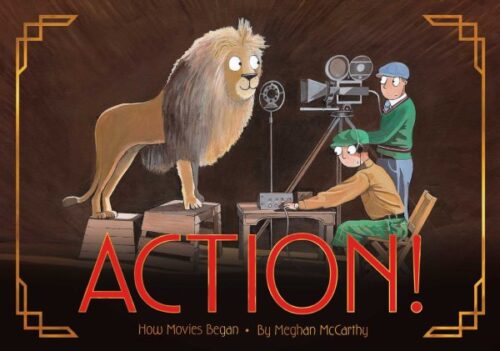
We all love movies but where did they even come from? A beautiful encapsulation of the birth of the silent film era, culminating in the talkies, and painted with McCarthy’s signature, always amusing style. McCarthy’s best work to date (and that’s saying something). I have always been a sucker for the way this woman paints eyes. And at times this book utilizes them in ways that remind me more of Terry Gilliam more than anything else,but the intricacy of her style, the choice of illustrations, and the sheer beauty of the scenes can’t help but impress. This is a stunning compilation of early film history, rendered comprehensible for kids. I love how she ties in movies they might already know to older films that they might not (the Metropolis to Star Wars link is particularly choice). The only flaw is that I didn’t want her to stop when she got to the talkies. More! More!
ADVERTISEMENT
ADVERTISEMENT
Blue by Nana Ekua Brew-Hammond, ill. Daniel Minter
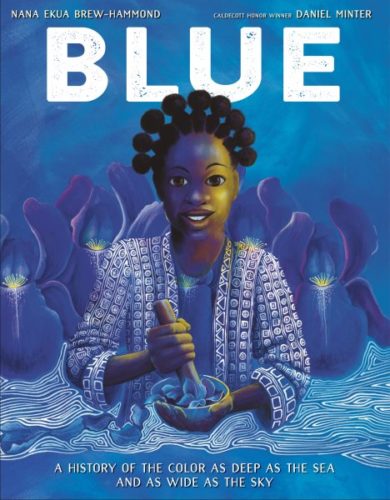


The color blue has meant so many different things to so many different people around the world. Take a deep dive into its history and the good, and bad, stories that lie behind the color of the sky. He’s back! He’s back! Daniel Minter is back! I’m just goofy about this guy’s art, and for good reason. That Caldecott Honor he won was no fluke. Every book he touches he turns to gold. What’s remarkable, though, is how good he is at selecting projects to illustrate. No two look the same, but each of them work brilliantly with his style. Take Blue here, for example. This is a work of straight up non-fiction. It’s the history of a color, but it’s also unlike so many of the histories we usually receive. For years I’ve wanted to see histories that give places beyond Europe their due. This book is the one I’ve been wanting to see for so long. It’s this deep dive that conducts a worldwide survey of blue in a wide range of cultures. Working in blue’s direct connection to the history of slavery is just an extra added layer. And with Minter throwing his back into the art, the whole enterprise ends up being one of the loveliest titles of the year. I’m charmed.
Call Me Miss Hamilton: One Woman’s Case for Equality and Respect by Carole Boston Weatherford, ill. Jeffery Boston Weatherford

Civil rights isn’t just marching in the streets. A lot of the time is taking people to court over injustices. Can you fight to have people call you a name with respect? Mary Hamilton did. The story of one brave woman’s work to be called “Miss Hamilton”, accompanied by emotive scratchboard art and photos. First off, not a fan of the cover. Once I was into the book I got really fond of Mr. Weatherford’s style, but I do not think that particular cover image is doing the book any favors. The actual text is fascinating since I’d never heard of this case before and Ms. Weatherford does a great job of bringing the historical context to the forefront. The real key with the art, aside from the scratchboard illustrations is the integration of photography. That shot of the nuns!
Choosing Brave: How Mamie Till-Mobley and Emmett Till Sparked the Civil Rights Movement by Angela Joy, ill. Janelle Washington

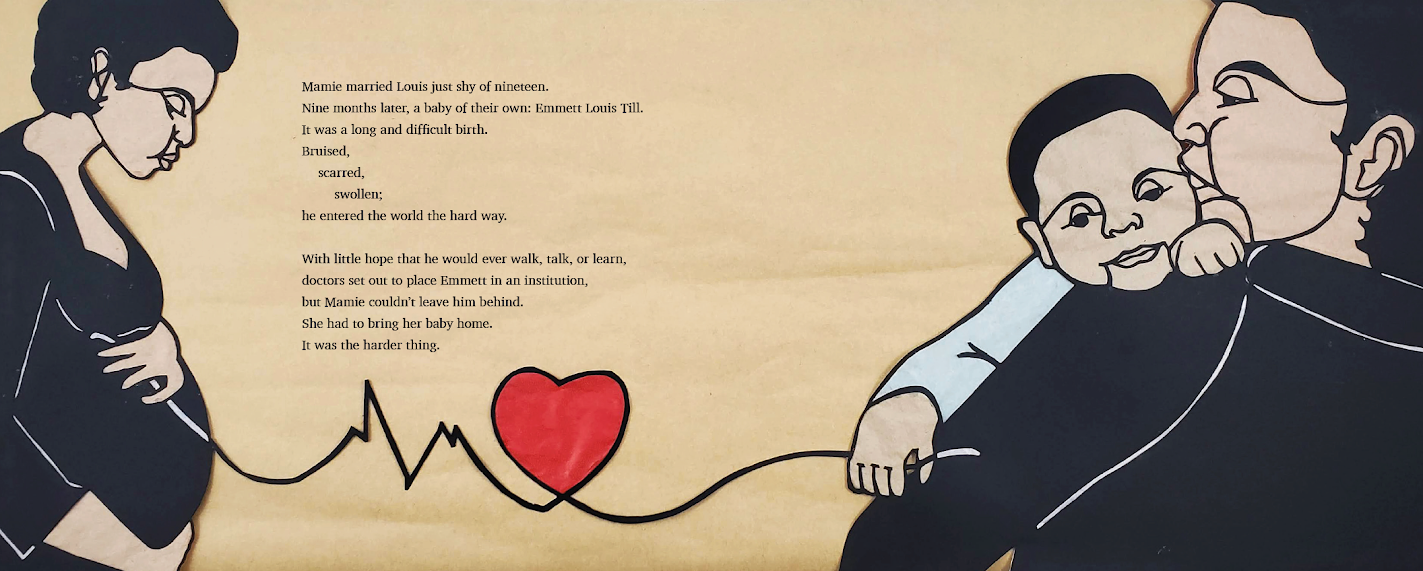
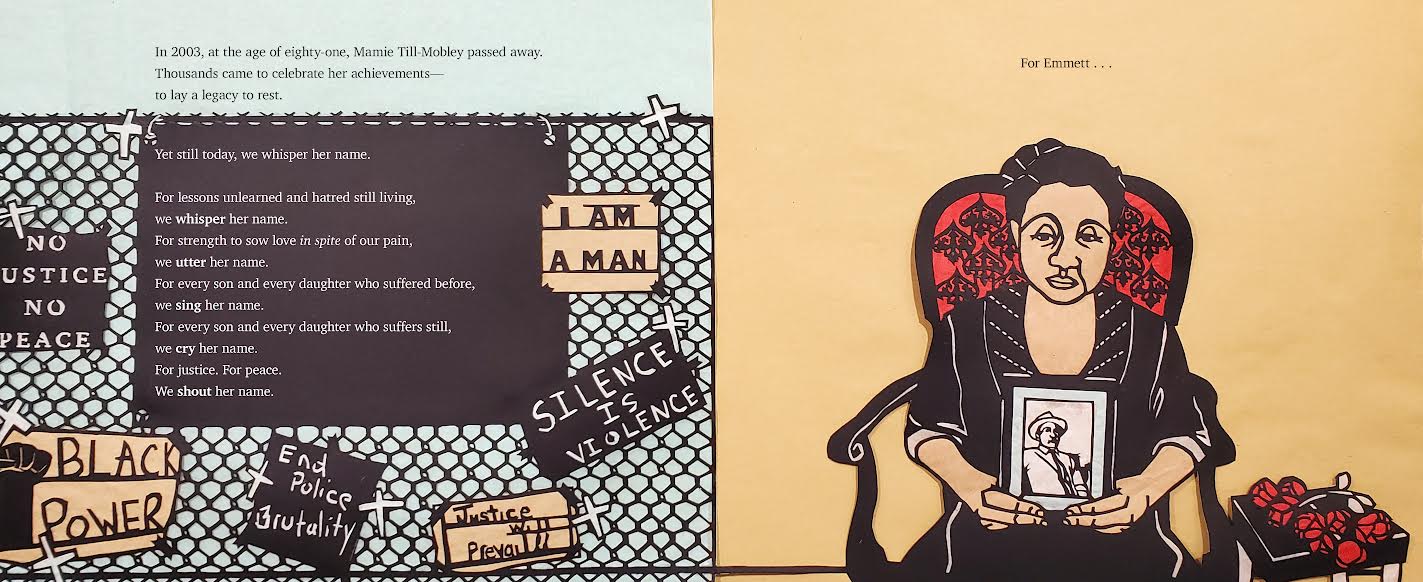
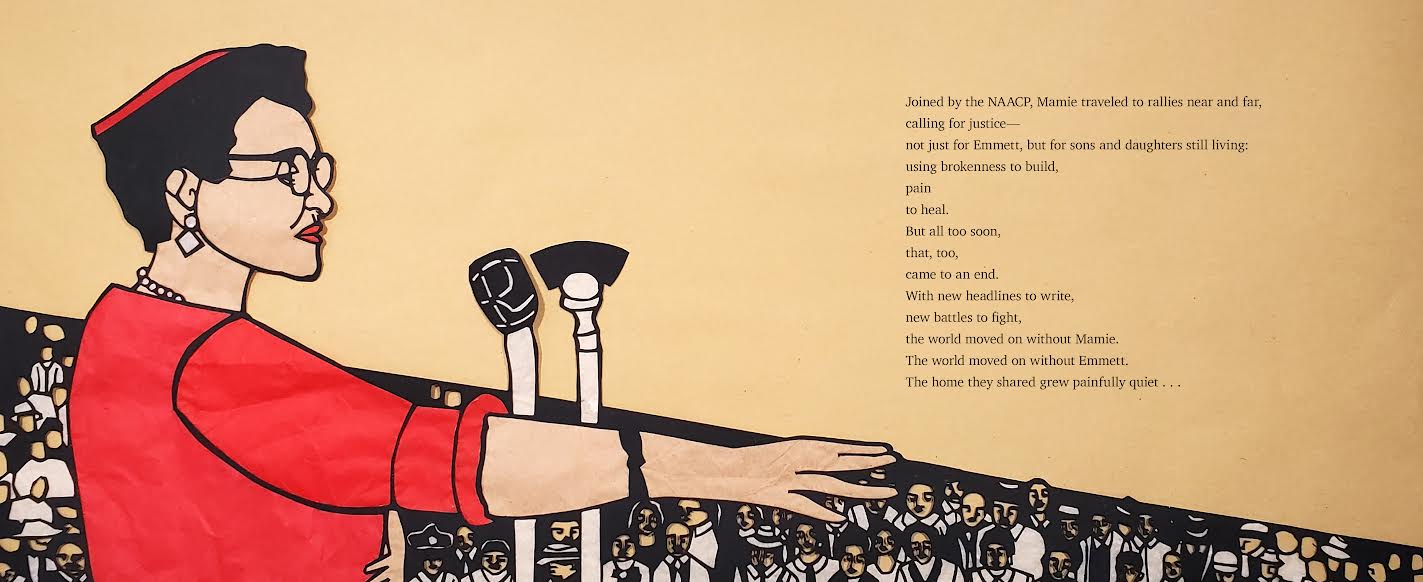
The life of Emmett Till’s mother highlights one woman’s lifetime of making brave, rather than easy, choices. Meticulous papercuts tell her story with dignity. Mmm. Chalk this up as an exceedingly smart take on how to frame the life and work of Mamie Till-Mobley. It’s really right there in the title. The book tells this woman’s life from start to finish, but the crux of it, what it all really hinges on, is the question of what one does when faced with a difficult decision. Do you make the easy choice or the brave choice? And it’s so well done, how it manages to tell Emmett’s story honestly without getting too gory for child readers. I just can’t believe that this is Janelle Washington’s first book either. This takes the art of papercutting to a whole other level. Seriously, this should be serious contender come award season. One of the best of the year. Easily.
Concrete: From the Ground Up by Larissa Theule, ill. Steve Light
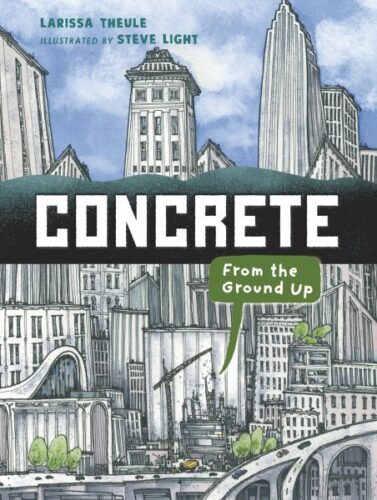
A highly amusing history of a material we all take for granted. From the Parthenon to the Berlin Wall, get the low down on concrete, what it’s made of, what it’s capable of, and where it might go in the future. I’m a 44-year-old woman and I’m not ashamed to admit that prior to reading this Theule/Light combo I was pretty unclear on the difference between concrete and cement. Now a history OF concrete may not sound particularly interesting to you, but think again. First off, you have Steve Light stretching himself out of his usual fictional wheelhouse with what is clearly the perfect project for his skills. Seriously, what brilliant editor tapped him to do this book? We’ve all seen him create elaborate cityscapes in books like Where’s My Dragon? so it makes all the sense in the world to use him for a book like this. He’s like David Macaulay mixed with Mark Alan Stamaty (10 points if you get what I’m saying). As for the text itself, I just found it amazing! The Romans had concrete but the recipe was lost? And I love including something beyond dead white civilizations in the text, like the Ethiopian monolithic churches and Machu Picchu in the Andes. As much as I usually dislike pure concrete structures, this book really made me appreciate what they’re capable of.
Dragon Bones: The Fantastic Fossil Discoveries of Mary Anning by Sarah Glenn Marsh, ill. Maris Wicks
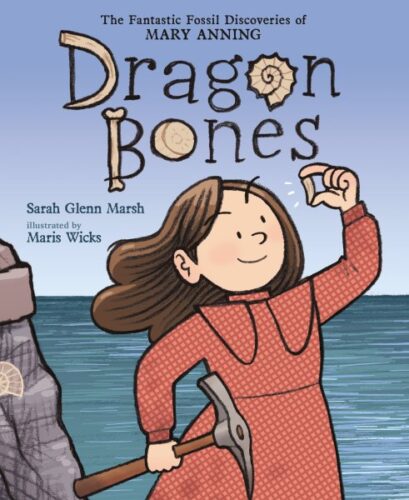
Since she was born in 1799, no one would have expected Mary Anning to be remembered as the mother of paleontology. But since she just keep digging up bigger, more impressive ancient sea creatures, what we know now would have been completely different without her. Oh, I LIKED this! Now admittedly this might partly be because I remember illustrator Maris Wicks from one of my favorite camping picture books Yes, Let’s. I love her style and how her seemingly simple art captures expressions and personalities so well. But let’s not give short shrift to Sarah Glenn Marsh! She does an excellent job of laying out not simply Mary’s life but also what the scientific community owes to her industrious nature. It’s a really neat story, not just about ancient fossils and paleontology, but also citizen science, the role of women, lack of attribution, and history itself. Extra points for the endpapers (where you can see the creatures as fossils at the front and as they would have looked at the end) and for the images of “Mary’s Dragons” particularly the Dimorphodon macronyx. It was so weird looking that I had to Google it, just to make sure Ms. Wicks wasn’t making up stuff (Google it yourself if you don’t believe me). Oh! And I LOVED LOVED LOVED the part that actually gives you practical information on how to become a paleontologist. Can we get that info in all our books about cool jobs, please?
Fighting for Yes! The Story of Disability Rights Activist Judith Heumann by Maryann Cocca-Leffler, ill. Vivien Mildenberger
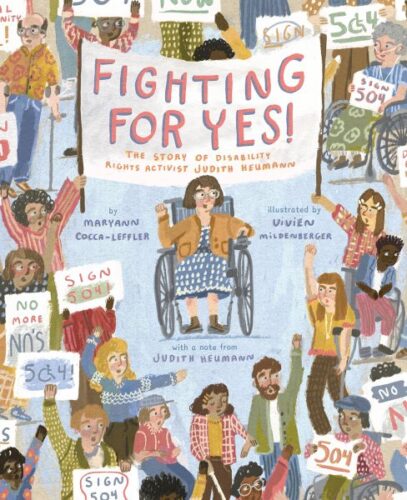
The history of disability rights in America is displayed through a single woman’s story. Can you imagine being told NO your entire life? The story of Judith Heumann’s life is stirringly presented and is sure to make activists out of each and every reader.To my mind, a good author is capable of making kids understand how deeply unfair something can be. And this story of Judith Heumann just bears down on the injustice of her education in ways I’ve never seen or, to be frank, thought of before. You’re just 100% on board with her from the get-go, and Mildenberger’s art makes for a great companion to the tale. 100 points for not making the title of this book some kind of pun on “Heumann”’s last name. Love the notes from Judith herself (it’s always good for kids to see bios of living people), the context in the Author’s Note, and the neatly made page of Selected Sources.
Going Places: Victor Hugo Green and His Glorious Book by Tonya Bolden, ill. Eric Velasquez
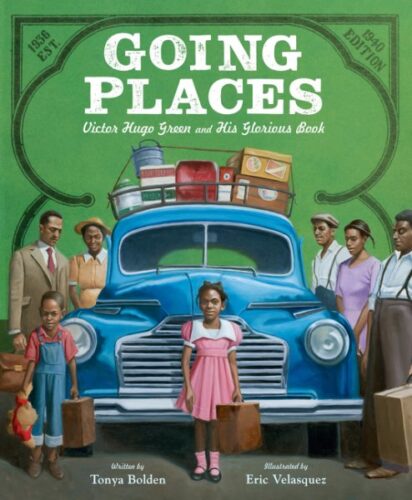
Thanks to racism, Jim Crow laws, and segregation, if you were Black and wanted to travel around the United States in early days of the family cars and highways, finding safe spots to stop could be hard. Victor Hugo Green made it a lot easier, and this peppy book shows how his Green Book made the world a safer place. Now THAT is what I’m talking about! Sometimes it’s hard for me to separate out how good a book is from how much better it is than a similar one that’s done this topic before. This is not, by any means, the first book on Victor Hugo Green that I’ve ever seen. It is, however, the best I’ve ever seen. Eric Velasquez is in his element and has pulled out every last stop that could have been pulled out. You know when you sometimes get the feeling that an illustrator is sleepwalking through a project? This is the opposite of that. Velasquez is clearly passionate about the subject matter and, just as important, he’s having fun with it. Tonya Bolden, meanwhile, is always good, but here she’s given just the right amount of context to surround the story itself. There’s a lot of “maybes” at the beginning, which I don’t love, but I don’t really mind either. And look at this design! This is historical picture book storytelling at its finest. At last, we finally have a book on this subject worth turning to again and again.
Good Eating: The Short Life of Krill by Matt Lilley, ill. Dan Tavis
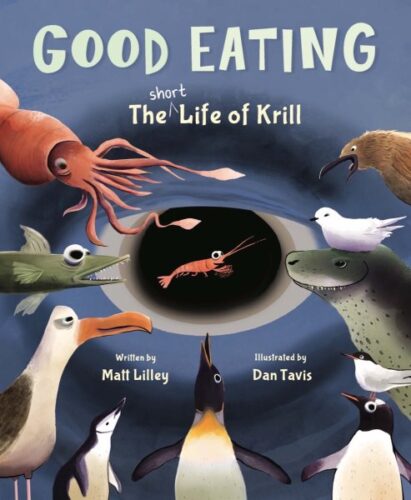
My true appreciation of a work of nonfiction for younger readers never burns brighter than when I am able to take a book, look it right in the eye, and say, “GAAAAHHH! NATURE IS SO WEIRD!!!” And friends, I am delighted to say that this little book by Lilley and Tavis, gave me that warm panicked feeling in my belly I always strive for. Yes, this is a book about krill. If you’re an adult like myself then you may know roundabout two facts about krill: 1. They are important to the oceans from an environmental standpoint and 2. Whales eat them by the truckload but they’re small. Therein begins and ends what I knew about the little buggers. That is also why I found GOOD EATING to be so delightful. Because Matt Lilley does not begin where you might expect him to. He starts with a shot of a single, solitary egg. “Hey, egg. What are you doing? Are you sinking?” Painted a luminous golden brown against a sea of black, the egg sinks down, more than a mile. Yet when it hatches, it’s still spherical. To my delight, your average krill is a far stranger story of metamorphosis than anything our butterflies can come up with. Constantly growing and shedding and growing and shedding (and not, for quite some time, eating) krill are shapeshifters. Even when they reach their final state, they’re still shedding armor. This deep dive into the microcosm of their lives is as elucidating as it is mesmerizing. You’ll never think about them the same way again.
Hidden Animal Colors by Jane Park
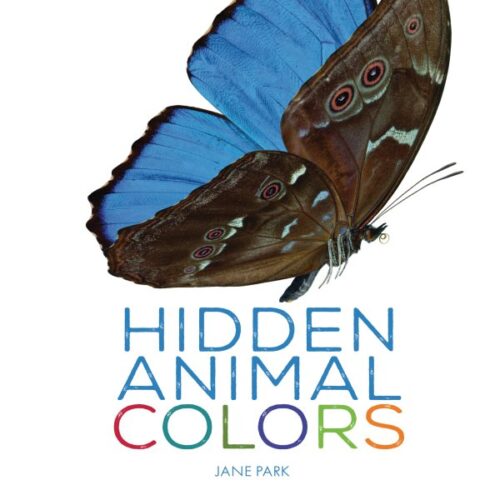
From brilliant green eggs to pink sweat and blue blood, the natural world loves a hidden surprise. Check out these creatures and critters, captured on film, in a book perfect for read alouds. Ahh. Younger nonfiction with a brilliant premise and marvelous photography. Now THIS is a STEM storytime readaloud, if ever I saw one. It grabs you right from the start with a magnificent, brilliant blue tongue, and just goes from there. The text and photos work perfectly in tandem, but what I really admired was the order in which you encounter each creature. It’s laid out very admirably. I can hardly think of a better book out this year to ensnare young readers into loving nature.
A History of Underwear with Professor Chicken by Hannah Holt, ill. Korwin Briggs
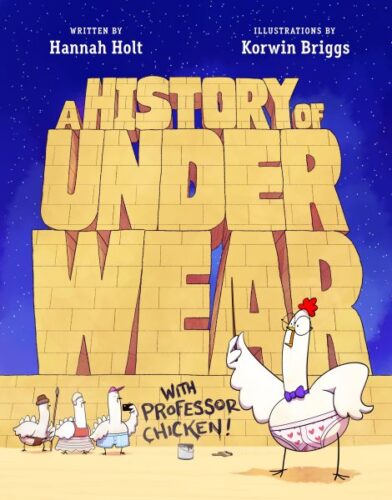
Thongs, corsets, hezi, and paper. Underwear from everywhere is celebrated in this poultry-filled tour, hosted by the delightful Professor Chicken. I mean, it’s chickens in corsets. I don’t know how you’re going to improve upon that. And really, the whole reason that this book works is that it ISN’T just corsets but a worldwide range of underwear from a wide variety of cultures. As such, when you get the European two-page spread of underwear through the ages, it is immediately following by the Chinese history (which covers a much wider range of time, as you might expect). I’ll admit that it took me a couple pages to get used to everyone being chickens but it really won me over. Besides. Chicken in corsets. That is good.
I Am Ruby Bridges by Ruby Bridges, ill. Nikkolas Smith
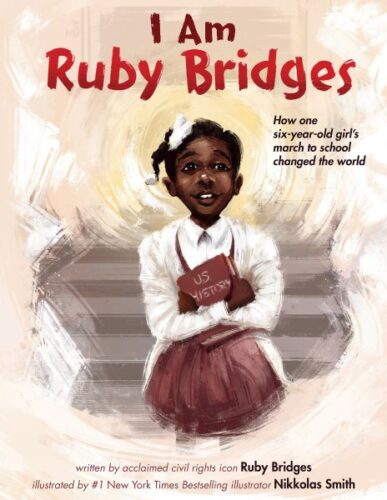
What’s it like to be Ruby Bridges? Why not let her tell you herself? Ruby recounts her famous youth, putting young readers right into the head of an average kid caught up in a historical moment. It probably says something unflattering about the state of children’s books today that I can look at the cover of this book and immediately my mind says, “Ugh. Another Ruby Bridges book”. Which, aside from being entirely unfair, is more a fault of an industry that churns out bios of the same people over and over than the title itself. And as nutty as it sounds, I actually was drawn to the book at first because Nikkolas Smith was the illustrator and I just loved his work on the 1619 Project book last year. I didn’t even realize that Ruby Bridges herself had written the book until I actually went to read it. Mind you, I’m under the impression that she’s done more than one book about her life over the years, so I took that into consideration. Still, this is a much better take on the story than any other picture book bio I’ve seen until now. Ruby really and truly puts you into the head of her 6-year-old self, confusion and all. You get this real sense of how bewildering the grown-up world is, shuttling her from place to place. Smith is, as always, on target with his art and the whole thing is a rousing success. Not your average Ruby Bridges book
If You’re a Kid Like Gavin: The True Story of a Young Trans Activist by Gavin Grimm and Kyle Lukoff, ill. J. Yang
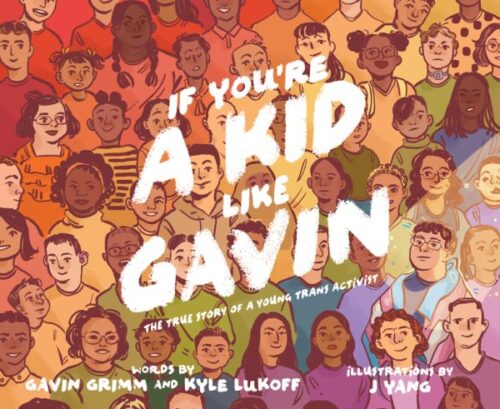
If you’re a kid like Gavin you shouldn’t have to make the choice to stand up for yourself as a trans boy who deserves to use the boy’s bathroom, but that’s just what he did. The inspiring tale of a modern child hero, expertly told. Yeah. I don’t want to make it look like I’m this instant fan of anything Kyle Lukoff does. It’s just that he does what he does better than anyone else. This is really well told and really well done. It helps too that J. Yang (what else has Yang done?) presents this really accomplished take on Gavin’s story. Kyle clearly is doing the verbal linguistics involving the repetition and slow introduction of the story. It doesn’t dance around what Gavin went through but, at the same time, I think it’s important that it doesn’t make things look as truly awful as I’m sure that they were for him. An important story that, particularly right now, needs to be told.
Jack Knight’s Brave Flight by Jill Esbaum, ill. Stacy Innerst
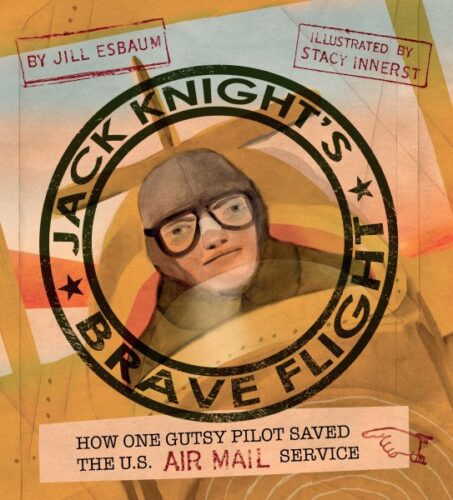
A gripping, edge-of-your-seat telling of the daring flight by one man to save air mail service in America. Best book. Worst cover. I have low tolerance for sepia mistakes. But boy is this a great example of how the writing of a nonfiction picture book really elevates the entire production. Esbaum’s no newbie and it shows. She knows how to really put you in the pilot’s seat. The exhaustion and tension and that moment when he almost falls asleep in the air. And then all those near misses or actual misses! A wonderful example of a book that plays fair with the material (sourcing all the quotes, not mucking up the facts) and comes off with a gripping, nail-biting, edge-of-your-seat bit of factual storytelling. Bravo!
A Kunwinjku Counting Book by Gabriel Maralngurra and Felicity Wright
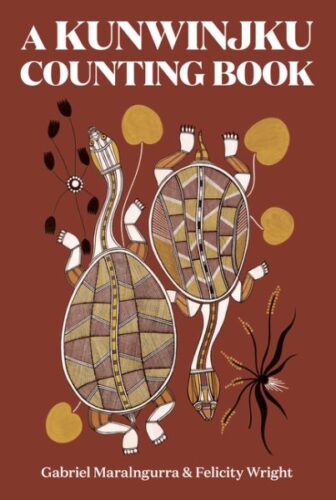
One, two, three. Nakudji, bokeh, danjbik. Join Aboriginal Australian artist Gabriel Maralngurra in this primer on Kunwinjku numbers and animals, gorgeously illustrated. I’m glad that I had a couple days to sit and think about this book. Initially I thought it was just your basic counting title, and I was going to slot it into the Picture Book section. Upon closer analysis, though, I think that at its heart this is a book about not just the natural world around us, but how some cultures, in this case different Aboriginal tribes living in the West Arnhem Land part of Australia, interact with these animals. It did not escape my notice that almost every animal, fish, insect, and other creature listed here also has a note included about how yummy they are. I can respect that. The art is absolutely enthralling as well. Artist Maralnguurra has been inspired by rock art, and part of what makes these and those paintings so interesting is their keen attention to the musculature and skeletons of whatever it is that they’re rendering. This book has a slow burn. Give it a try.
A Land of Books: Dreams of Young Mexihcah Word Painters by Duncan Tonatiuh
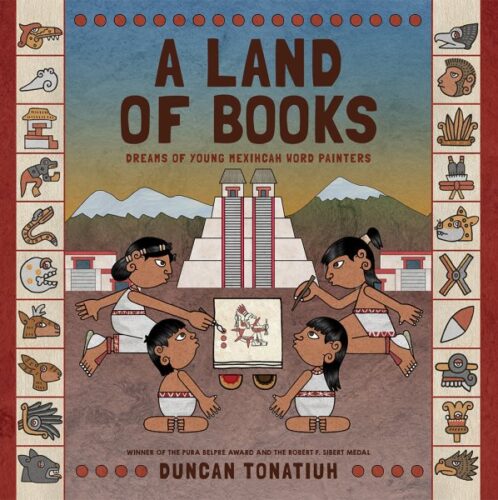
Join two kids as they watch their parents make amoxtin (Mixtec books) out of knowledge and history. A fabulous history of early Mesoamerican book culture. That’s what I’m talking about! I like Duncan Tonatiuh’s style but I don’t always like his books as much as I feel I should. He picks great subjects, has great art, and then sometimes the end result is . . . perfectly decent. You know what I mean. But finally I see that he’s hit on a subject that rivals its endmatter in terms of interest. Now I may be a bit overly swayed, as can sometimes happen, by the fact that it’s about something I never knew before. I mean, were y’all already aware that the Mexihcah and their Mesoamerican neighbors made books on paper? Thousands and thousands of paper books? This title almost straddles the fiction/nonfiction line, but I’m cool with it since I feel like the experiences of the kids here would have been the experiences of actual kids (and it’s all kept appropriately vague) Plus Tonatiuh’s style blends absolutely seamlessly with the real books that he’s talking about. Fun, a great take on the subject matter, and you learn so friggin’ much!
Listen to the Language of the Trees: A Story of How Forests Communicate Underground by Tera Kelley, ill. Marie Hermansson
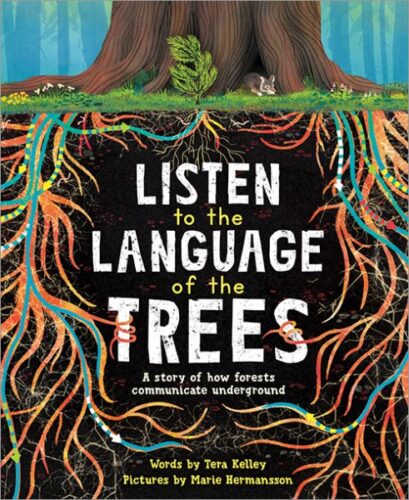

Think trees can’t communicate? Think again. Trees have a whole underground system of sending nutrients, messages, and even alarm systems to one another. Learn more about this amazing wood wide web. You’ll never look at a tree the same way again. Finally! I’ve been waiting and waiting for this book to come out. Ever since I first learned about the marvelous methods trees have of communicating and sending one another help, I’ve wanted a book like this one to exist. And we’ve seen some books that vaguely alluded to the wood wide web (not my phrase) but nothing that really went this deep into it. This book, honestly and truly, will make you look at trees differently when you read it. Not too long ago I was in Michigan and found myself staring at trees along the highway, trying to figure out which ones were the matriarchs that helped everyone else. This book is marvelous and necessary. Yay, trees!
Make Way For Animals: A World of Wildlife Crossings, by Meeg Pincus, ill. Bao Luu
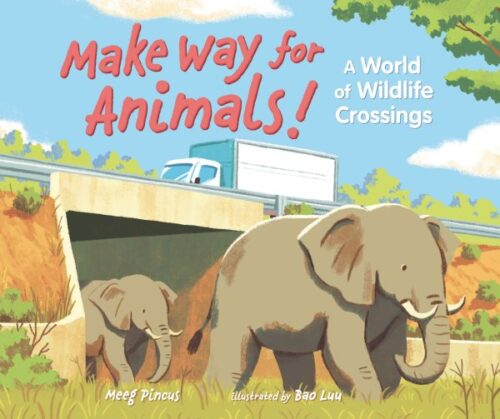
Take a tour of wildlife crossings across the globe, from grassy badger bridges to underpasses for elephants. Discover how these inventive pathways have saved both animal and human lives and helped preserve ecosystems. A year or two ago I almost missed a book on animal crossings called Crossings by Katy S. Duffield (to say nothing of Cougar Crossing by Meeg Pincus). So it is with great pleasure that I see that I’ve found another wildlife crossing title, and, not only that, it’s great! Those videos of the crabs of Christmas Island have always given me a lot of stress, since I worry for them so much. As such, you can understand how thrilled I was to see their truly bizarre, entirely vertical, crossing mechanism. I love the structure of this book and how it sets up the animals in the first part and their individualized solutions in the second. I love the innovation it takes to help them (and how it’s in everyone’s best interests, not just the animals themselves). Great backmatter with photographs, info on what kids can do, and a Bibliography. This is a real treat.
Marcel’s Masterpiece: How a Toilet Shaped the History of Art by Jeff Mack
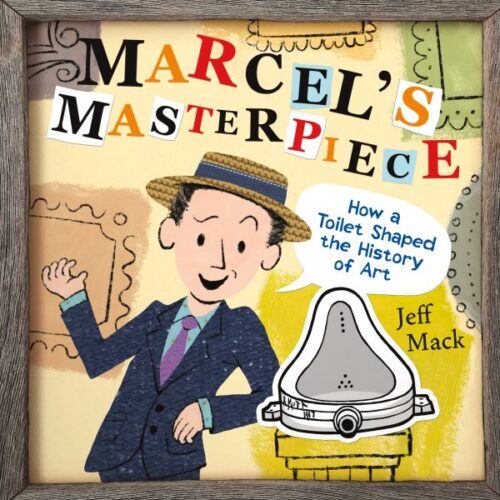
What is art? Let Marcel Duchamp help you answer that question. He once turned a toilet into an artistic statement, and the world was never the same again. I like it when children’s books take great big ideas and synthesize them down to their most essential parts. And what question could be bigger than “what is art?” I think people are still wrestling a lot with this one, and Mack proves to be a perfect guide. Now usually I hate fake dialogue but give special dispensation to fake dialogue when it’s in speech balloons, because I think that makes it clear that this is a cartoon reenactment and not (if there are quotation marks) something someone actually said. Fun and exceedingly simple, this has all the hallmarks of a book designed to make young children think. It’s also a nice intro to the idea that we can all have different ideas about something and, at least in the case of art, that’s okay.
Mega-Predators of the Past by Melissa Stewart, ill. Howard Gray

Forget the dinosaurs! Meet the REAL (and enormous) mega-predators of the past. All but one is extinct… but which one? Ahhh. This is like the book Actual Size meets … uh …. stuff that could eat you. It’s clear from the outset that Stewart knows how to do this nonfiction stuff, and do it well. This takes some standard elements in books in terms of scale and makes them fun. For example, every time they show a little person’s silhouette for scale, that silhouette is usually fleeing, falling, flailing, or trying to defend itself from the animal being discussed. The writing itself is fun and funny (it’s continually besmirching dinos and how they dominate discussions of ancient predators). And then you get to the explanation of how Stewart did her research and you are left with NO doubts that this book is, for this moment, as accurate as it could possibly be.
Out of the Shadows: How Lotte Reiniger Made the First Animated Fairytale Movie by Fiona Robinson
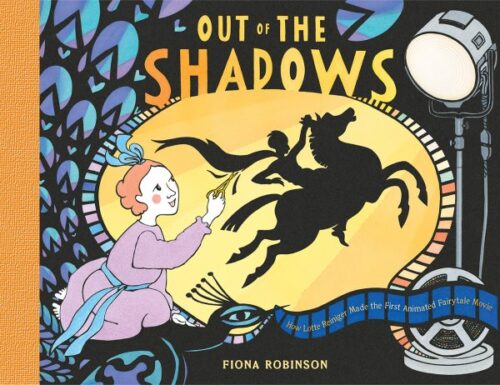
Who knew that a love of fairytales could turn into something so amazing? The story of one of the world’s earliest animators and how she brought her tales to life in a whole new way. I am just out-and-out in love with this book. Who wouldn’t be? This title is a perfect marriage of subject and artistic skill. I once heard a podcast episode on Lotte Reiniger, but this really breaks down how groundbreaking she was. Her invention of the multiplane camera (which I believe they used in Bambi) and the debt female animators pay to her today (I love that the book mentions a Steve Universe homage) make this one of the best picture book bios I’ve seen in a long time. I even love the exact moment they chose to end her story. Exceedingly clever. A biography that wakes you up to what the form can be.
Pink, Blue, and You! Questions for Kids About Gender Stereotypes by Elise Gravel with Mykaell Blais
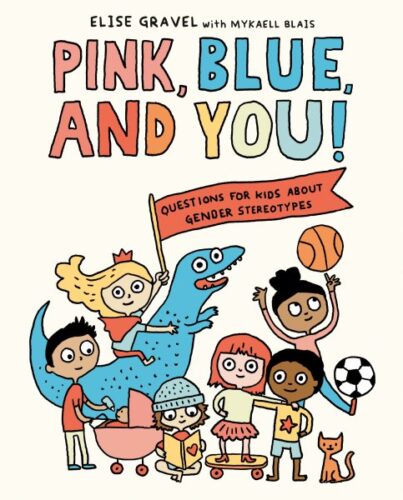
The gender spectrum is explained in clear, concise language for the young in this fun breakdown of sometimes complicated topics. Gravel has repeatedly proven that no topic with her inimitable style is impossible for her to tackle. Mushrooms. Immigration. Bugs. And now gender stereotypes. Any author or illustrator is, by definition, limited in what they can do. I feel like Gravel, however, is aware of her limits and yet continually pushes against them. She tackles difficult topics and turns them into smooth, clear, understandable explanations for the young. This book looks deceptively simple, but is exceedingly hard to pull off. Take a look and bear in mind, while you do, how many “meh” books we’ve seen on this subject before. I think this one’s a pretty clear stand-out.
Pizza: A Slice of History by Greg Pizzoli
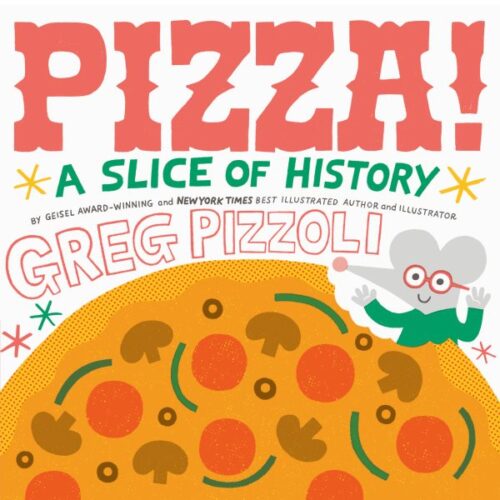
Take a deep (dish) dive into the history of pizza with your faithful companion Pizza Rat. Learn its true origins and gather some facts you might not have known in this cheery book with a retro look. Boy, I wish Mr. Pizzoli did more nonfiction. Greg just has this endearing, simple style that’s so appealing to look at! I worry that he got disappointed by the sales of his brilliant book about the guy who sold the Eiffel Tower and got turned off of the whole idea. But now he’s back! He’s back and have you ever seen a better nonfiction storytime title than this one? It’s great nonfiction for younger readers as well (which we’re always looking for). Good hearted and delicious. What more could you wish for?
Polar Bear by Candace Fleming, ill. Eric Rohmann

A mama bear and her two cubs wake from their winter hibernation and search for food. A gripping, beautifully illustrated account of the toll global warming takes on species. Shoot. I was all prepared not to take the latest Fleming/Rohmann collaboration seriously since I’d already lavished SO much love and affection on their bee book from a year or two ago. Plus, polar bears? So done. So very done. I’ve read more nonfiction picture books for them than I can count. And then there Candy goes being an actual author and making me really really REALLY care about the fate of these baby bears. On top of that, I thought I knew everything there was to know about them, only to find myself incredibly wrong. It’s a bit of a thrill too to see Rohmann doing polar bears again too (remember, he did the book jackets for the American editions of The Golden Compass back in the day). So I’m an official fan of this book. Didn’t wanna love it. Had no choice in the matter.
Sanctuary: Kip Tiernan and Rosie’s Place, the Nation’s First Shelter for Women by Christine McDonnell, ill. Victoria Tentler-Krylov
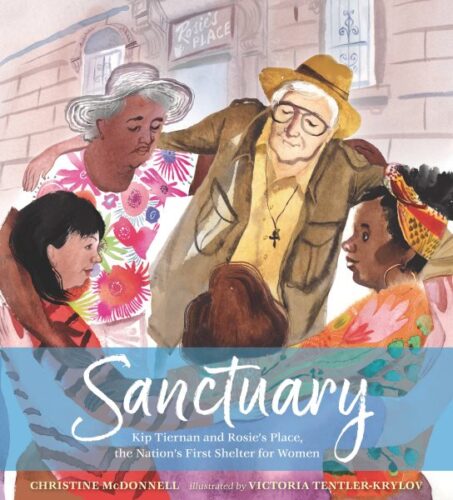
In a time when men without housing had shelters to stay in but women did not, Kip Tiernan saw the problem and got to work. A moving tale, beautifully told. This one really won me over. I’ve little patience for good-hearted but ultimately dull books. This one, in contrast, is good-hearted and good! In keeping with much of what I’ve already said twice today, I’m not a huge fan of the cover, of course (which sort of makes it look like some kind of lovey dovey circle of love), but I just adore what Tentler-Krylov is doing with her watercolors here (she can replicate fur better than almost anyone). This is ultimately a story about building empathy, and I won’t lie to you. When that bus driver comes up to the elderly Kip and tells her “It’s because of you that I ate when I was a child,” I got teary. Honestly, emotionally resilient and very worthy.
Shapes, Lines, and Light: My Grandfather’s American Journey by Katie Yamasaki
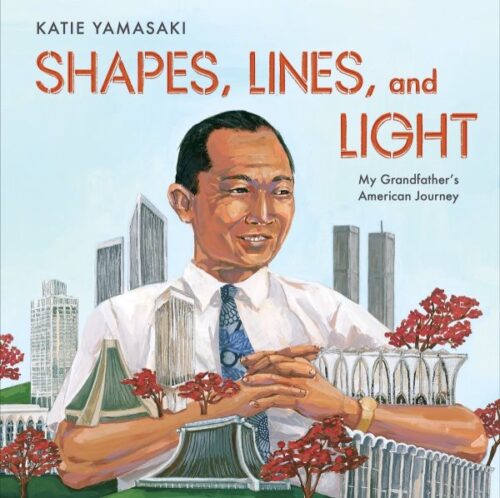
“Serenity. Surprise. Delight.” Japanese-American architect Minoru Yamasaki used that mantra throughout his life. Now his granddaughter is able to tell his journey, with all its ups and downs. You gotta feel for Katie Yamasaki. Her grandma was a classically trained pianist. Her uncle won a Pulitzer. And her grandpa designed the freakin’ Twin Towers. But she certainly has pushed herself farther than ever She’s using all her skills to tell the story of that grandfather and I was really impressed by how she chose to lay out his story. The book follows Minoru throughout different historical moments in time. It’s a really impressive tale of pursuing your dream job in spite of your own government labeling you “the enemy”. And winning! At the same time, I loved that Yamasaki doesn’t color his life as one sweet ride after he established his own architecture firm. This is a really human look at both a grandfather and a great artist. Certainly worth your consideration.
The Snail by Emily Hughes
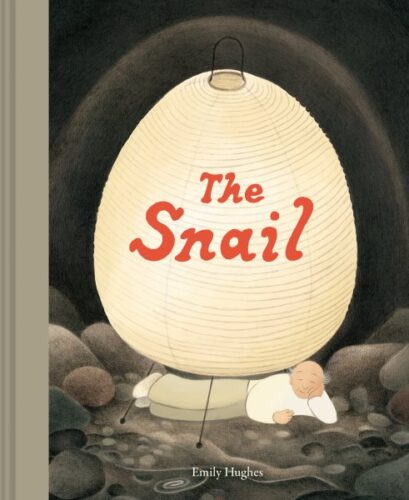
The life of Japanese-American sculptor Isamu Noguchi is revealed in this brief and brilliant look at how the experiences of his life informed the beautiful Akari lamps he created in his later years. A meditative look at the creative process. Let the record show that there was nothing about the title, cover, or author/illustrator of this book that indicated to me that it was a picture book bio of sculptor Isamu Noguchi. It was only as I read it that I had the slow, dawning realization that what I was reading was true. Even so, it’s such a fascinating and REMARKABLY well-written take on the man’s life and art. Hughes really delves deep into the “why?” of his art, particularly his Akari, which were considered too commercial when he debuted them. There’s so much to pick apart here. The snail motif, use of light, his grumpiness, etc. It’s not a standard picture book biography by any means, which is probably why I like it so much. A beautiful departure for Hughes.
Solitary Animals: Introverts of the Wild by Joshua David Stein, ill. Dominique Ramsey

Vibrant pulsating images show how solitary animals and social animals differ. Simple words show how it’s okay to be by yourself, just like eagles, panthers, sloths, and more. Introverts of the world rejoice! We have found your animalian equivalents. This luscious but exceedingly simple book has one job and does it well. All it wants is to show how some animals exist in groups while others are happy alone. The backmatter is slightly wordier, but it keeps its points short and sweet. For example, humans are social animals that sometimes want to be solitary. And that’s okay.
Sweet Justice: Georgia Gilmore and the Montgomery Bus Boycott by Mara Rockliff, ill. R. Gregory Christie

An everyday hero gets the praise she deserves in this stirring tale of how one woman supported and aided the people engaged in the Montgomery Bus Boycott. A marvelous example of how a single life can make a difference. Knowing the sheer number of biographies we see by the end of the year, I’m not 100% certain this book will make it to the end, but I’d like to see some more reads on it at the very least. I don’t even think that this is the first picture book bio I’ve read of Georgia Gilmore, but I really like Rockliff’s take on not just her life but also how we as individuals can learn from her actions. This is a book about empathy and giving everything you have for what you believe in. Now, going in to this, it’ll help if you’re already a fan of Mr. Christie’s art, because he gets a bit loose in some spreads (purposefully, I’d say). I just thought that this was an excellent example of what a picture book biography is supposed to do: Show how a single person’s actions speak beyond the times in which they lived.
Time to Shine: Celebrating the World’s Iridescent Animals by Karen Jameson, ill. Dave Murray
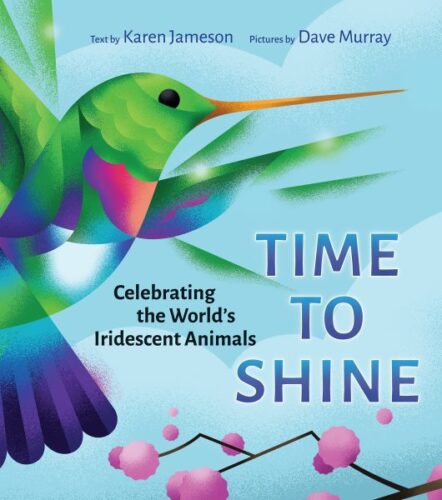
Do iridescent animals that gleam with flashing rainbow colors have that shine just to be pretty? Not on your life. Learn the science, secrets, and splendor behind some of the world’s most gorgeous creatures. It’s a bit of a challenge to dare to go so far as to write a book about iridescence if you’re a small book publisher like Groundwood. I imagine the biggies would have loads of cash to throw at their books, filling them with Rainbow Fish-esque iridescent interiors. This book, instead, has to rely entirely on artist Dave Murray’s ability to conjure a representation of iridescence without presenting it himself. You will find a bit of foil on the cover around the title for reference, but it’s awfully spare. All that aside, the information in this book is a lot of fun. I just figured iridescence was created to attract mates, and that does appear to be the most common reason, but there are other interesting applications as well, like frightening off a predator, confusing their eyes. There’s a nice list of Sources at the back and I got so intrigued by the notion of the Caihong juji (a duck-sized dino with, apparently, iridescent feathers) that I want a whole book about THAT now!
To Change a Planet by Christina Soontornvat, ill. Rahele Jomepour Bell

Can one person affect a whole planet? A very young picture book for budding environmentalists shows just how important each and every person is to Earth’s future. Proving yet again that she can literally write any kind of children’s book you can name (she has produced a graphic novel, middle grade fantasy, a picture book bio at least in 2022), Soontornvat is adding “quiet nonfiction environmental paean” to that list. This book seems tailor made for young child Earth Day storytimes. The words are incredibly simple but combined with Bell’s art they convey sentiments that go far beyond the book’s seeming simplicity. It’s a book meant to show how important a single person is to the planet and how important that planet is. Beautifully written with some killer art. The best version of this kind of book.
To the Front: Clara Barton Braves the Battle of Antietam by Claudia Friddell, ill. Christopher Cyr
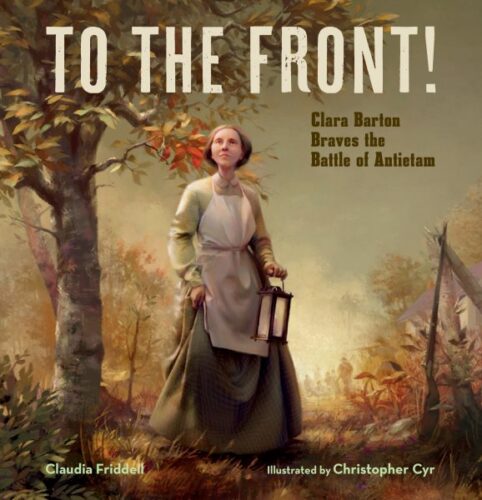
Imagine walking into a war zone with no supplies, just waiting for horrendously injured men to start arriving. Clara Barton’s life is brilliantly rendered in this tale of a true American hero. I did NOT expect to like this. First off, I’m really prejudiced against any books for kids with brown or sepia-toned covers (see: JACK KNIGHT’S BRAVE FLIGHT). They just scream “BORING!” to me. But this is probably the best example I could name of a picture book bio with extraordinarily good writing that elevates its subject. By the time you get to the end of this book you’re ready to up and join the Clara Barton fan club. It’s like, as I read this, I kept trying to find reasons to not like her and, every time, she would upset those expectations. It’s also beautifully sourced and does this trick right at the start of stating that Clara’s words are in blue or brown bold italics while the author’s are in a plain font. The backmatter? *chef’s kiss*. Folks. Don’t let the cover fool you. You gotta read this!
The Tower of Life: How Yaffa Eliach Rebuilt Her Town in Stories and Photographs by Chana Stiefel, ill. Susan Gall
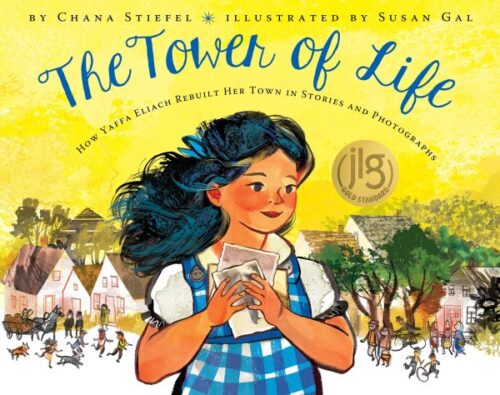
What do you do when an entire town is erased? How do you remember the people that lived there? Yaffa Eliach found a way to bring the stories and lives of the Jewish village of Eishyshok to the world. A beautiful celebration of life. When you’ve a great big subject like the Holocaust out there then I cannot stress enough how exceedingly difficult it can be to write any thing for kids on the topic. I have read a lot of nonfiction picture books on the Holocaust in my day, but this may, and I mean this truly, be one of the best I’ve ever seen. I had to sit on it a little while to take it in. I know that when the only Jewish content you have on a list is Holocaust content then that is hugely problematic. But the whole reason this book works for me is because what it centers on isn’t the tragedy but the life of the people that lived in this small town of Eishyshok. The integration of photography with the illustrations (which are Susan Gal’s, so you know they’re going to be amazing) is so seamless that it actually reminds me quite a bit of the aforementioned older nonfiction book Seen and Unseen by Elizabeth Partridge. It’s an original story that adapts to the picture book form exceedingly well.
The Universe in You: A Microscopic Journey by Jason Chin
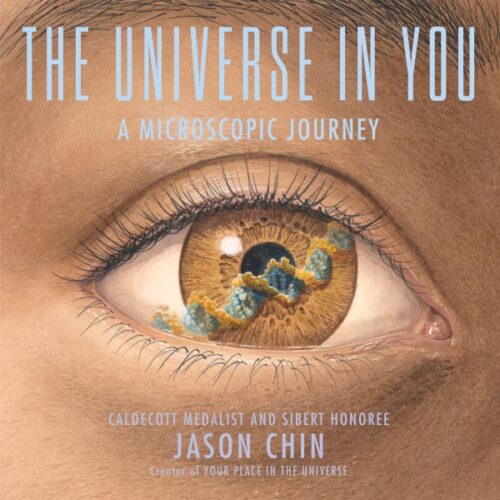
What is the tiniest, smallest thing in the known universe? From a delicate hummingbird to elementary particles and everything in-between, take a trip into your cells and our selves. So this is an interesting case. Considering that Chin’s last book (Your Place in the Universe) was also SO successful, I could acknowledge this book as equally awesome since it’s so much harder to show something getting smaller and smaller as opposed to bigger and bigger. But that said, its really remarkable quality is that Chin is most successful at trying to make such complicated ideas understandable for kids. The elementary particles were my favorite part (and I appreciated his mentioning at the end that he was just winging it on what they looked like). Well worth discovering.
Washed Ashore: Making Art from Ocean Plastic by Kelly Crull, art by Angela Haseltine Pozzi

There’s a lot of plastic in the ocean. What to do? Artist Angela Haseltine Pozzi collected it, then turned it into magnificent sculptures of sea creatures. Waste and beauty go hand in hand with a keen environmental message. I had a bit of difficulty figuring out whether or not this book should go in the picture book or older reader section. In the end, I think that this is the best place for it since it really is a picture book and the longer text could be completely optional, if needs be. The real reason that this book works as beautifully as it does is that it does several things simultaneously, widening its appeal. There’s the cool sculpture component, of course, but there’s also the seek-and-find element where you’re asked to find different plastic items in the sculpture. Then you get these cool action steps for kids on the one hand next to the bulkier text. That text could be read to kids with a real yen for the subject matter, or you could ignore it. It’s totally optional. I think there’s a lot of appeal here, and a great environmental message packaged in a way that lots of people can hear and understand.
Where Butterflies Fill the Sky: A Story of Immigration, Family, and Finding Home by Zahra Marwan
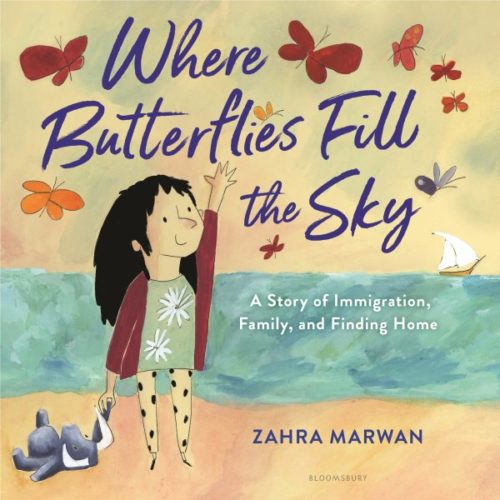
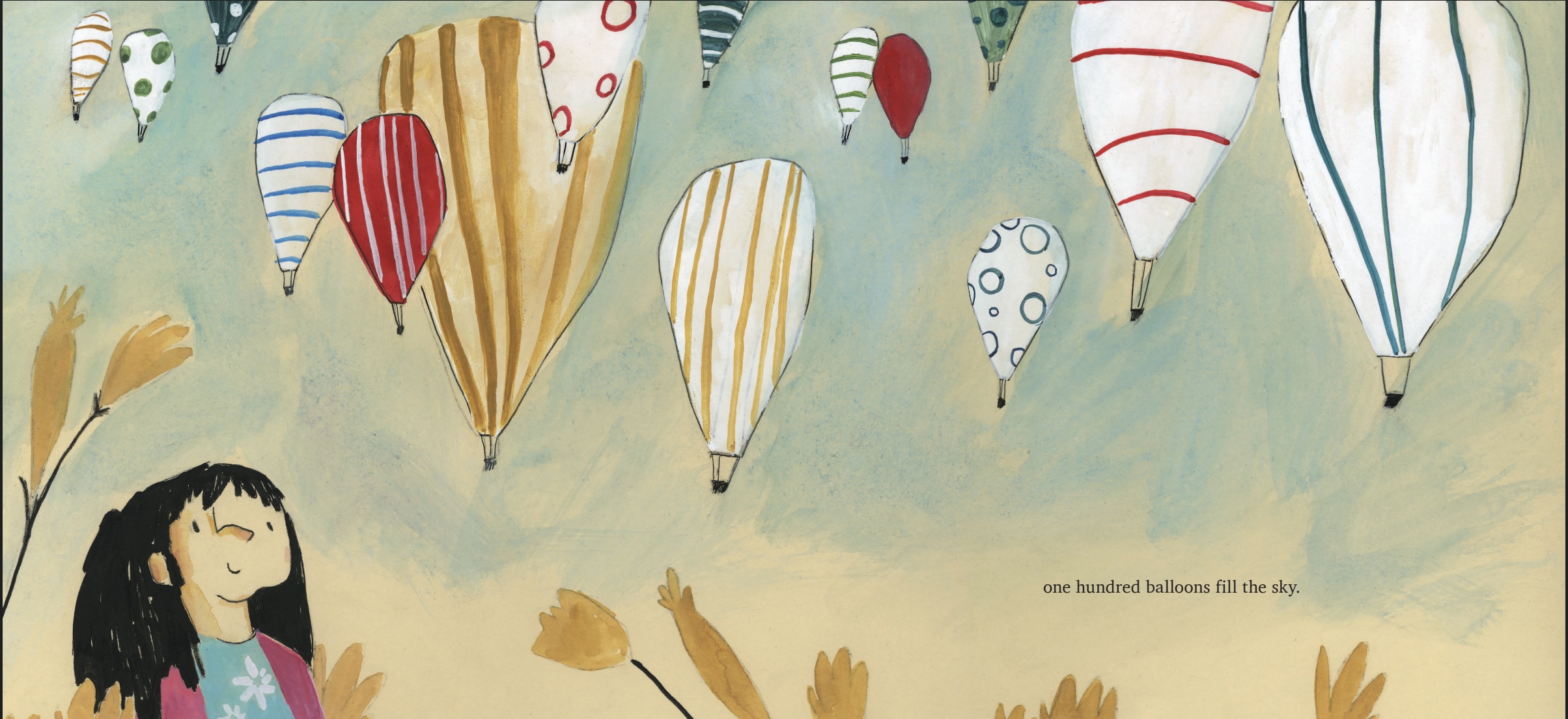
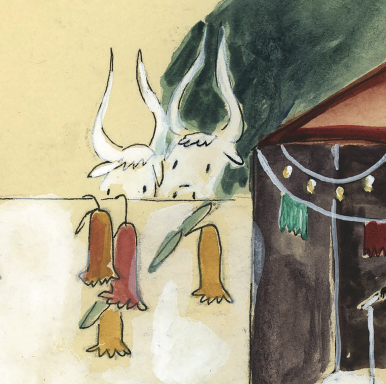
What happens when you have to leave your home where the desert reaches all the way to the sea and one hundred butterflies always fill the sky? An immigration story told with humor, heart, and remarkable art. At this point we’ve seen a fair number of picture books about the immigration process. They’re widely varied, and often incredibly harrowing (just remember last year’s Wishes). Rarely can they afford any lightness or a sense of humor. That may be what makes this little autobiography about Marwan’s life stand out as much as it does. The combination of Kuwaiti and New Mexico art styles is particularly fascinating. I found this to be a breath of fresh air, with some truly informative backmatter. Absolutely love the aunts too. This is a winner.
Want to see other lists? Stay tuned for the rest this month!
December 1 – Great Board Books
December 2 – Picture Book Readalouds
December 3 – Simple Picture Book Texts
December 4 – Transcendent Holiday Picture Books
December 5 – Rhyming Picture Books
December 6 – Funny Picture Books
December 7 – CaldeNotts
December 8 – Picture Book Reprints
December 9 – Math Books for Kids
December 10 – Gross Books
December 11 – Books with a Message
December 12 – Fabulous Photography
December 13 – Translated Picture Books
December 14 – Fairy Tales / Folktales / Religious Tales
December 15 – Wordless Picture Books
December 16 – Poetry Books
December 17 – Unconventional Children’s Books
December 18 – Easy Books & Early Chapter Books
December 19 – Comics & Graphic Novels
December 20 – Older Funny Books
December 21 – Science Fiction Books
December 22 – Fantasy Books
December 23 – Informational Fiction
December 24 – American History
December 25 – Science & Nature Books
December 26 – Unique Biographies
December 27 – Nonfiction Picture Books
December 28 – Nonfiction Books for Older Readers
December 29 – Best Audiobooks for Kids
December 30 – Middle Grade Novels
December 31 – Picture Books
Filed under: 31 Days 31 Lists, Best Books of 2022
About Betsy Bird
Betsy Bird is currently the Collection Development Manager of the Evanston Public Library system and a former Materials Specialist for New York Public Library. She has served on Newbery, written for Horn Book, and has done other lovely little things that she'd love to tell you about but that she's sure you'd find more interesting to hear of in person. Her opinions are her own and do not reflect those of EPL, SLJ, or any of the other acronyms you might be able to name. Follow her on Twitter: @fuseeight.
ADVERTISEMENT
ADVERTISEMENT
SLJ Blog Network
One Star Review, Guess Who? (#211)
Kevin McCloskey on ‘Lefty’ | Review and Drawn Response
Notable NON-Newbery Winners: Waiting for Gold?
The Seven Bills That Will Safeguard the Future of School Librarianship
Take Five: Newbery Picks, Part Two
Gayle Forman Visits The Yarn!
ADVERTISEMENT



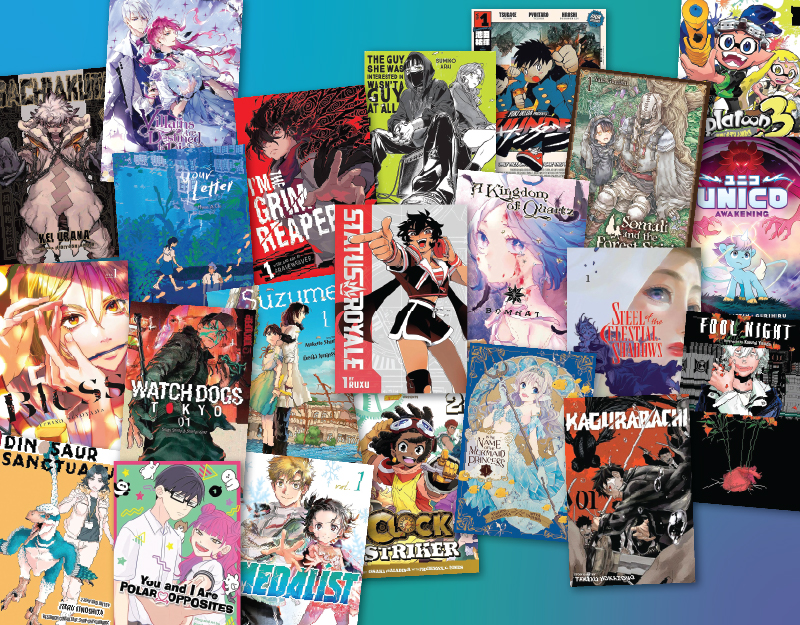
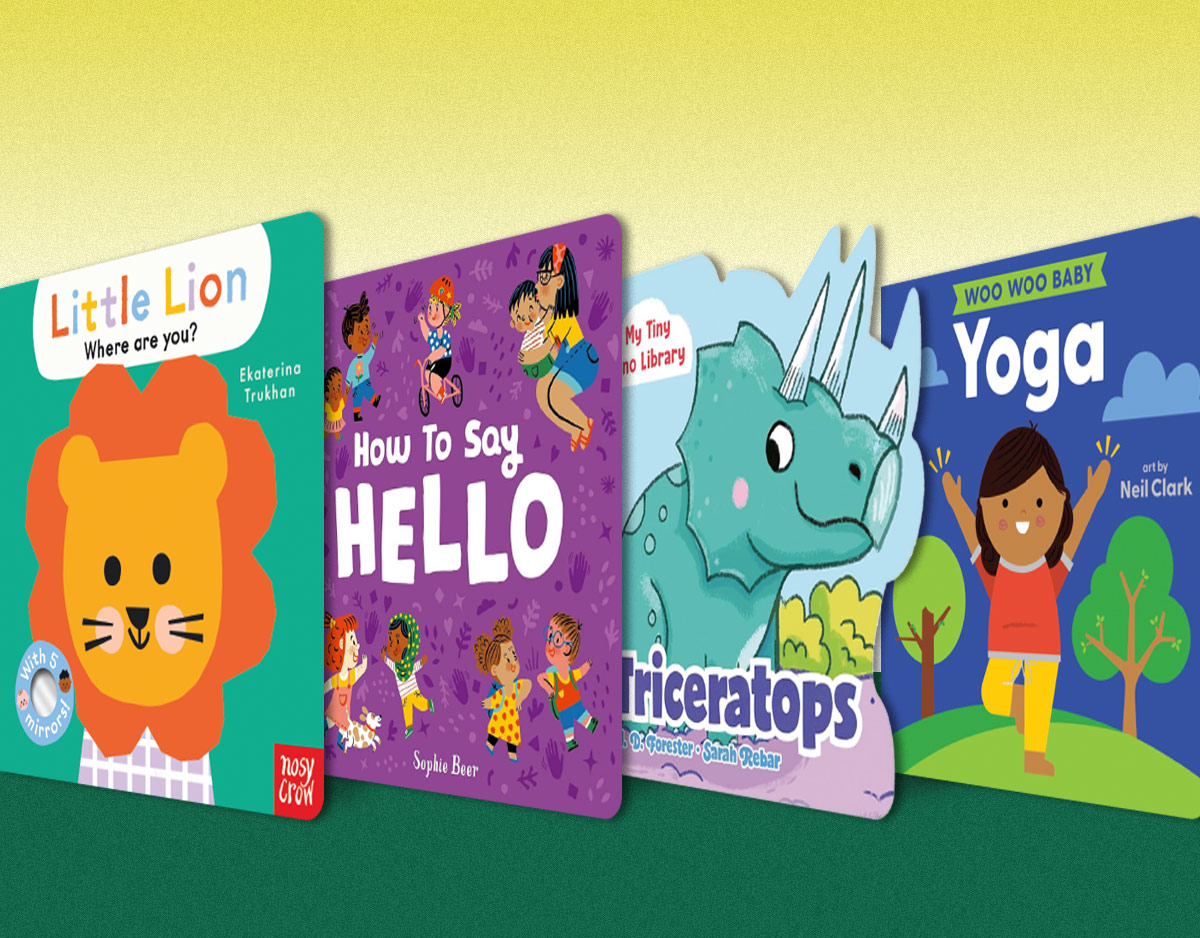

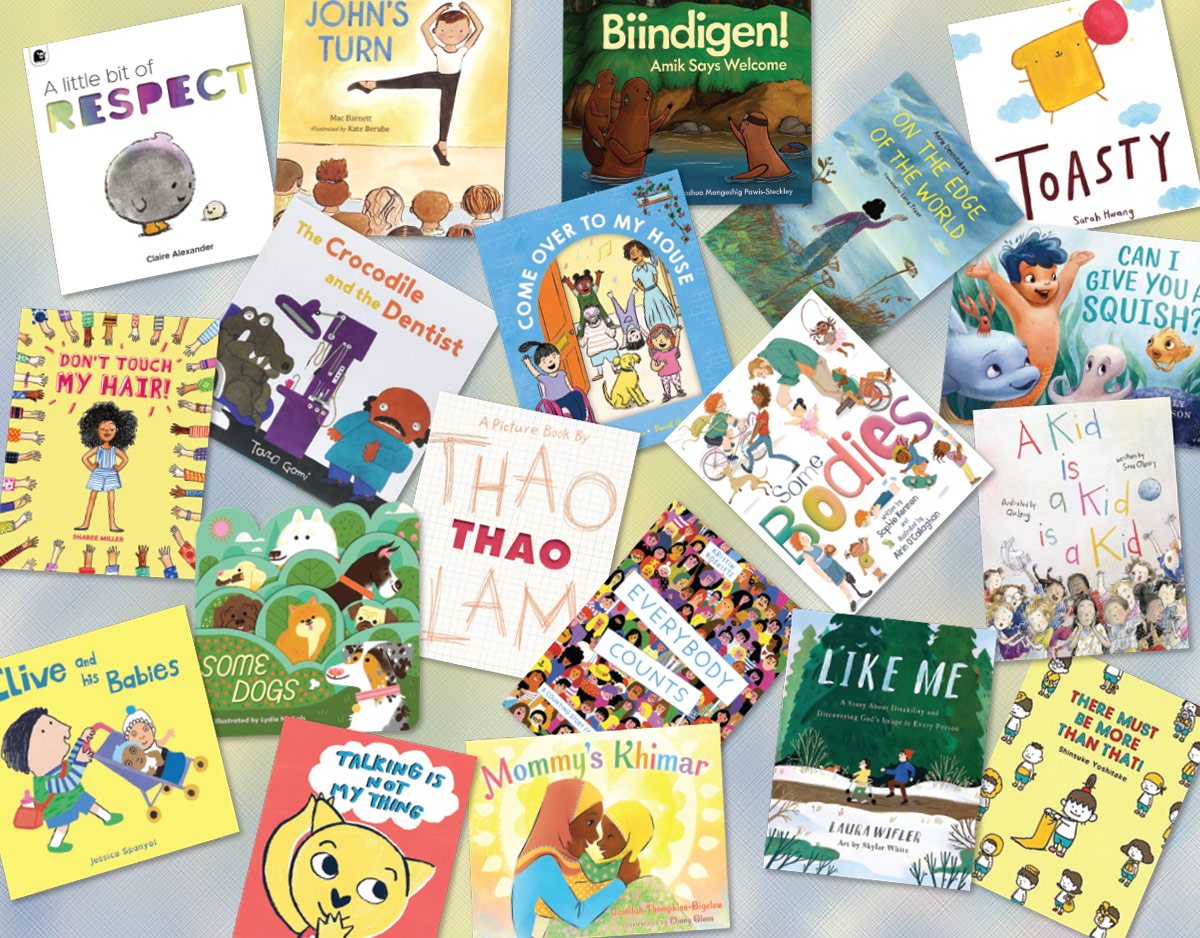

Thank you! Love your lists. I chose The Tower of Life by Chana Stiefel and Susan Gal &
Choosing Brave: How Mamie Till-Mobley and Emmett Till Sparked the Civil Rights Movement by Angela Joy, ill. Janelle Washington for my NF Book Discussion Group. 🙂